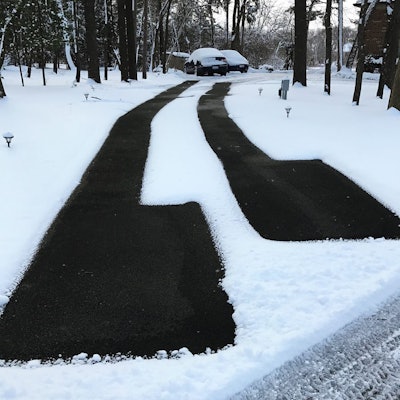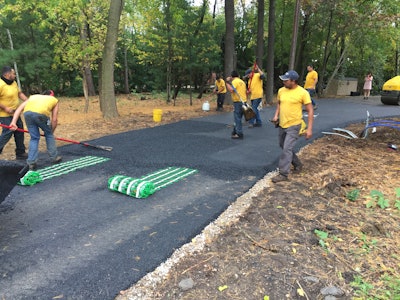 Photo: WarmlyYours
Photo: WarmlyYoursSnow is probably the last thing your customers are thinking about in June, yet when winter comes, they do know they don’t want to be the one outside shoveling it.
The search for snow removal solutions is reflected in WarmlyYours Radiant Heating’s Q1 2019 Industry Report, which showed sales of their snow melting products increased by 174 percent from the previous year. The 2018-2019 winter featured record-breaking snowfalls and frigid temperatures and in response, both residential and commercial customers are seeking out different snow melting options.
“Even though we’ve been selling snow melting systems for many years, there are still a lot of people who haven’t heard of heated driveways,” says Julia Billen, owner and president of WarmlyYours Radiant Heating. “We’ve been fortunate enough to have a YouTube video of ours that shows a snow melting installation reach over 1.5 million views (with tens of millions of additional views via other social media platforms) and the consumer interest has been fantastic.”
In the Q1 2019 report, it was shown the fastest growing snow melting products were the 208V and 277V cables at 391.7 percent and 222.6 percent growth, respectively. These products are typically used for commercial settings.
“I’m sure that the salt shortage last winter had at least a partial impact on the demand for snow melting systems, particularly for commercial property managers who have to ensure a snow and ice-free surface for liability reasons,” Billen says. “Of course, the primary motivator for both the salt shortage and the increased demand in snow melting systems was the higher than average snowfall levels across much of the country, particularly in February.”
If your clients are located in region that frequently has to deal with winter’s wrath, here’s what you need to know about snow melting products and if offering them is a good fit for your landscaping business.
Benefits
When a snowstorm hits, you’re probably familiar with your phone ringing off the hook with many customers wanting to know when your crews will get there to plow. This “me first” attitude among homeowners can be challenging to ensure everyone is satisfied.
 Photo: WarmlyYours
Photo: WarmlyYours“One primary benefit is that it (a snow melting system) can help cut down on number of clients that require immediate assistance after a snowstorm,” Billen says. “This will help prevent customer frustration if they’re not waiting for their turn to be dug out of the snow. Another advantage of snow melting systems is that once the snow is melted and evaporated, there will be no residual ice left behind, which can sometimes occur when snow is plowed or shoveled way.”
Billen adds that being able to provide a snow melting solution expands your catalog of available services.
“It’s interesting to note that we’ve also seen an increase in customers seeking chemical-free snow melting options, citing both concerns about the well-being of pets and ecological reasons,” Billen says.
She says part of the increased interest in snow melting systems is from the baby boomer generation wanting ways to “age in place” by making their walkways, driveways and patios safer in the wintertime.
“For aging clients or clients with mobility concerns, it’s about more than just convenience —having a snow melting system can vastly improve their overall safety and quality of life,” she says.
Installation process
If your customers have expressed interest in having you install a snow melting system, the first thing to discuss is the cost.
According to Billen, the heating elements cost $8-$16 per square foot for cables or $10-$20 per square foot for mats. There is also the cost for a control and WarmlyYours’s most popular option is around $800.
 Photo: WarmlyYours
Photo: WarmlyYours“However, the actual operating cost for a system is much more affordable than typical snow removal services,” she says. “For example, to melt the snow in a typical driveway after a normal snowfall, it would cost about $9. There are a lot of variables that will impact that cost (like the size of the project and the cost of electricity in the area) but typically, this number is going to be lower than paying someone to shovel or plow.”
Customers can also use WarmlyYours’s operating cost calculator to get a rough estimate for how much a snow melting system would cost to run based on project size and electricity costs in their area.
When it comes to choosing between snow melting cables or mats, it boils down to cost and speed of installation. The heating elements are the same and have the same heat output of 50-watts per square foot.
The mats feature the cable already attached to mesh at 3-inch spacing, cutting down on the installation time, but it is the more expensive option. The cables are cheaper but require more effort to make sure proper spacing is maintained.
As for the advantages of choosing to use a WarmlyYours snow melting system, Billen says there are two main advantages: their custom installation plans and 24/7 technical support.
“Our SmartPlan custom installation plans, and entire design process as a whole, ensures that you’ll get the proper product and design instructions for your project,” she says. “This ultimately saves time during installation and makes sure that the system will function optimally for the end user for many years to come. Our 24/7 technical support can prove crucial for answers to onsite questions that require immediate answers during the installation or with any troubleshooting questions down the line.”
Once your client has decided what type of snow melting product they want to go with, the system can be installed whenever a new outdoor surface is installed, from early spring to fall. Billen says early fall is the most popular time for installations.
 Photo: WarmlyYours
Photo: WarmlyYoursThe installation of heating elements does require additional time to ensure that it is properly embedded up between 1.5” to 3” from the finished surface.
“This is to make sure that the heat is close enough to melt the snow and ice but is still embedded in enough material to prevent the cables from overheating,” Billen says.”
For asphalt surfaces, this is typically achieved by laying a binder coat, staking the heating elements and then covering them in another layer of asphalt. In concrete installations, the heating elements are attached to a rigid framework and then propped up to the proper height before the rest of the concrete is poured.
“We do recommend that a licensed electrician perform the electrical connections themselves so that is another factor to consider,” Billen says.
After installation, there isn’t much maintenance to speak of aside from cleaning the sensors in order to ensure functionality.
When it comes to how long it takes for the snow to melt from a surface, a number of factors come into play including the ambient temperature and the rate of snowfall.
“However, we typically inform customers that our snow melting systems can melt between 1” and 3” of snow per hour, depending on atmospheric conditions,” Billen says. “We also recommend between 3 to 5 hours of additional run time after the snowfall stops so that the left behind moisture can fully evaporate (to avoid ice formation).”










